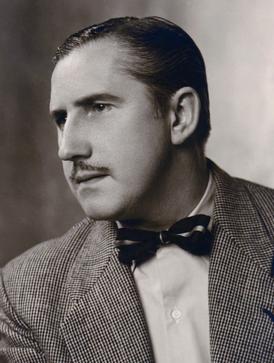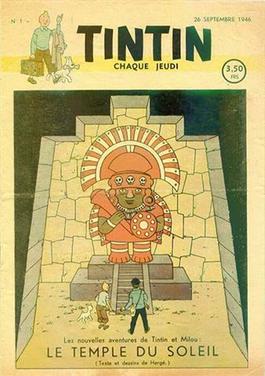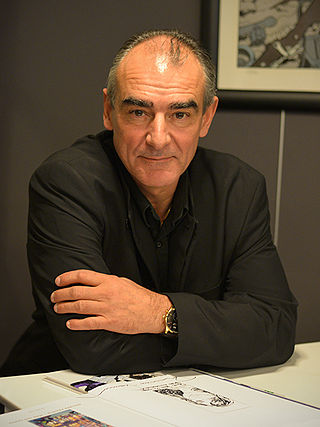This article needs additional citations for verification .(October 2011) |

Le Rayon U (The U Ray) is a comic book written and drawn by the Belgian comics creator Edgar P. Jacobs in 1943. [1]
This article needs additional citations for verification .(October 2011) |

Le Rayon U (The U Ray) is a comic book written and drawn by the Belgian comics creator Edgar P. Jacobs in 1943. [1]
In 1941, the outbreak of war between Germany and the United States meant that American comic strips could no longer be imported into Nazi-occupied Europe. [2]
Alex Raymond's strip, Flash Gordon , was then being published in the Belgian Franco-Belgian comics magazine Bravo . Artist and former opera singer, Edgar Pierre Jacobs was therefore asked to bring the current story to a satisfactory conclusion, which he did. He was then commissioned to produce a science fiction comic strip of his own. Le Rayon U ("The U-Ray") began serial publication in Bravo in 1943. [1] [2] This version had text boxes which described the action and the dialogues in the style of many Belgian comics of the time, similar in a way to Hal Foster's version of Tarzan and Prince Valiant .
In 1974 Jacobs reformatted Le Rayon U in order to include speech bubbles. This version was published in Tintin magazine and in book form by Dargaud-Le Lombard.
The cartoonist Jean Van Hamme will give a sequel to the Le Rayon U titled La Flèche Ardente will be released in 2023, the sequel is scripted by Van Hamme and illustrated by Christian Cailleaux and Étienne Schréder. [3]
English translations of both Le Rayon U and La Flèche Ardente were published by Cinebook in September 2023 and scheduled for February 2024, respectively.
Le Rayon U is set on an Earth-like planet which combines elements of the distant past, present and far future. Two of its nations, Norlandia and Austradia, are in conflict. A Norlandian scientist, Marduk, has devised a weapon called the "U Ray", but requires a mineral called uradium in order to put it to actual use.
Marduk therefore organises an expedition into an unknown part of the planet in order to find the uradium. Those accompanying him include: his assistant Sylvia Hollis; the explorer Lord Calder; Adji, Calder's Indian manservant; and Major Walton and Sergeant Mac Duff of the Norlandian secret service.
The explorers encounter all manners of threats, including prehistoric monsters, giant snakes and tigers, a tribe of hostile ape-men, and the meddling of Austradian spy Captain Dagon. More welcoming, but no less intriguing, is a civilisation of Aztec-like people.
In itself Le Rayon U is a classic of Belgian science fiction, but the influence of Flash Gordon cannot be denied:
Dagon, the main villain, was modelled on Jacobs himself. Marduk, Calder and Dagon were to be the models for Mortimer, Blake and Olrik, in Jacobs's classic series Blake and Mortimer .

Flash Gordon is the protagonist of a space adventure comic strip created and originally drawn by Alex Raymond. First published January 7, 1934, the strip was inspired by, and created to compete with, the already established Buck Rogers adventure strip.

Ligne claire is a style of drawing created and pioneered by Hergé, the Belgian cartoonist and creator of The Adventures of Tintin. It uses clear strong lines sometimes of varied width and no hatching, while contrast is downplayed as well. Cast shadows are often illuminated, and the style often features strong colours and a combination of cartoonish characters against a realistic background. The name was coined by Joost Swarte in 1977.

Jean, knight Van Hamme is a Belgian novelist and comic book writer. He has written scripts for a number of Belgian/French comic series, including Histoire sans héros, Thorgal, XIII and Largo Winch.
Publication of comic strips and comic books focusing on science fiction became increasingly common during the early 1930s in newspapers published in the United States. They have since spread to many countries around the world.

Grzegorz Rosiński is a Polish comic book artist, illustrator and painter. He is best known for providing the artwork for the series Thorgal. His other notable work includes art drawn in the Hans and Chninkel series of comic books.

Edgard Félix Pierre Jacobs, better known under his pen name Edgar P. Jacobs, was a Belgian comic book creator, born in Brussels, Belgium. He was one of the founding fathers of the Franco-Belgian comics movement, through his collaborations with Hergé and the graphic novel series that made him famous, Blake and Mortimer.

Blake and Mortimer is a Belgian comics series created by the writer and comics artist Edgar P. Jacobs. It was one of the first series to appear in the Franco-Belgian comics magazine Tintin in 1946, and was subsequently published in book form by Le Lombard.
Le Lombard, known as Les Éditions du Lombard until 1989, is a Belgian comic book publisher established in 1946 when Tintin magazine was launched. Le Lombard is now part of Média-Participations, alongside publishers Dargaud and Dupuis, with each entity maintaining its editorial independence.

Société Dargaud, doing business as Les Éditions Dargaud, is a publisher of Franco-Belgian comics series, headquartered in the 18th arrondissement of Paris. It was founded in 1936 by Georges Dargaud, publishing its first comics in 1943.

Belgian comics are a distinct subgroup in the comics history, and played a major role in the development of European comics, alongside France with whom they share a long common history. While the comics in the two major language groups and regions of Belgium each have clearly distinct characteristics, they are constantly influencing one another, and meeting each other in Brussels and in the bilingual publication tradition of the major editors. As one of the few arts where Belgium has had an international and enduring impact in the 20th century, comics are known to be "an integral part of Belgian culture".

Tintin was a weekly Franco-Belgian comics magazine of the second half of the 20th century. Subtitled "The Magazine for the Youth from 7 to 77", it was one of the major publications of the Franco-Belgian comics scene and published such notable series as Blake and Mortimer, Alix, and the principal title The Adventures of Tintin. Originally published by Le Lombard, the first issue was released in 1946, and it ceased publication in 1993.

Philippe Francq is a Belgian comic book artist, best known for the series Largo Winch.

Paul Cuvelier was a Belgian comics artist best known for the comic series Corentin, published by Le Lombard, which first appeared in the first issue of Tintin magazine.
Jacques Van Melkebeke was a Belgian painter, journalist, writer, and comic strip writer. He was the first chief editor of Tintin magazine and wrote scripts and articles anonymously for many of their publications.
Thierry "Ted" Benoit was a French comic artist, graphic novelist and prominent figure in the stylish Franco-Belgian ligne claire comics scene in the 1980s. His influences included Edgar P. Jacobs, Moebius, Robert Crumb and to a lesser extend Jacques Tardi.
Jacques Laudy was a Belgian comics artist who contributed to the early issues of the weekly Tintin magazine.

Yves Sente is a Belgian comic book editor and author. He is known as a writer for XIII, Blake and Mortimer and Thorgal.

The Belgian Comic Strip Center is a museum in central Brussels, Belgium, dedicated to Belgian comics. It is located at 20, rue des Sables/Zandstraat, in an Art Nouveau building designed by Victor Horta, and can be accessed from Brussels-Congress railway station and Brussels Central Station.
Le Club des bandes dessinées was the first organized association of French devotees to the comic strip as art form. It was founded in May 1962. In 1964 the Club was renamed the Centre d'études des littératures d'expression graphique.